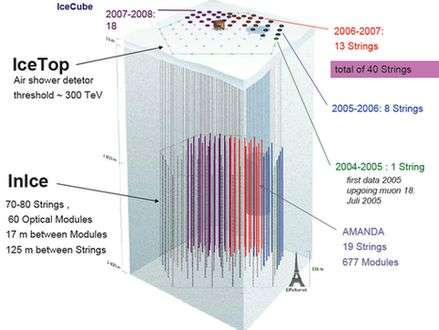February 29, 2008 feature
AMANDA's First Six Years

The most recent results from the Antarctic Muon and Neutrino Detector Array, or AMANDA, located a mile under the ice at the South Pole, have yielded the most stringent prediction yet for the highest possible rate that neutrinos from deep-space gamma-ray bursts can reach Earth—even though AMANDA did not conclusively detect even one neutrino from any astronomical sources during its first six years. The analysis is published in the February 10, 2008, edition of The Astrophysical Journal.
It seems counter-intuitive, but detecting nothing is informative in and of itself. It tells scientists that AMANDA is not yet sensitive enough, and has not run long enough, to determine the rate that gamma-ray-burst neutrinos arrive. More importantly, it tells the AMANDA collaboration that there is a limit to the amount of neutrinos that are generated in gamma-ray bursts.
Ultimately, AMANDA may help scientists better understand gamma-ray bursts, ultra-powerful releases of energy that occur when a star collapses and becomes a black hole or when two stars merge.
AMANDA's data was correlated with photon data taken in the Northern Hemisphere that correspond to more than 400 gamma-ray bursts that occurred between 1997 and 2003 (during that time period, AMANDA was the largest detector of its type). AMANDA “points” down into the earth toward the Northern Hemisphere and, because only neutrinos can reach it from that direction (neutrinos are the only particles able to pass straight through Earth), AMANDA uses Earth itself to eliminate other types of particles that might interfere with the detector.
Gamma-ray-burst neutrinos are extremely energetic, with 90 percent of them expected to have energies between 10 TeV (trillion electron volts) and 3 PeV (quadrillion electron volts). This, coupled with the fact that physicists know so little about neutrinos—even their masses are unknown—makes it very difficult to determine the rate that neutrinos pass through a given area.
As such, AMANDA cannot detect gamma-ray-burst neutrinos directly. Instead, it detects muons produced in the ice as the neutrinos pass through. These muons emit light called Cherenkov radiation, which the detector can record using its hundreds of light-detecting optical modules, which collectively act like a giant three-dimensional digital camera. Scientists can then work backward to learn about the original neutrino interaction and thus the neutrinos themselves.
AMANDA yielded a “flux upper limit,” rather than an outright flux value. This means that theoretical neutrino fluxes above this upper limit are likely incorrect. Flux predictions lower than this limit cannot be ruled out yet, though, because AMANDA is not sensitive enough.
AMANDA's key results are its “Model Rejection Factors”—numbers applied to other flux models that indicate how close AMANDA is to proving them false. For example, when AMANDA's results were compared to one model, the Model Rejection Factor was 0.5, meaning that model's flux prediction is twice as high as AMANDA's—and thus AMANDA has proven it to be way off. For another model, the Waxman-Bahcall flux, the Model Rejection Factor was 1.3. This means that AMANDA's upper limit is 30% too high to rule it out. Equivalently, it means that AMANDA need only to yield a flux upper limit 30% lower to nullify Waxman-Bahcall.
Said the paper's corresponding author, The Ohio State University astrophysicist Kyler Kuehn, to PhysOrg.com, “A good analogy to how AMANDA determines a 'flux limit' would be the way that human eyes function. You could determine observationally whether it is day or night by looking outside for the sun. If there is no region of the sky where your eyes detect an exceptionally bright source of light, you have gained the useful information that the sun is not in the sky.”
“On the other hand,” he added, “as those who have looked at the night sky with binoculars or a telescope know, just because you can't see faint objects (like distant stars) with your eyes, that doesn't mean they're not there. That just means that your eye is not sensitive enough, and therefore your 'flux limit' does not rule out the possibility of such stars actually being in the sky. Similarly, AMANDA has ruled out the possibility of neutrinos coming to us from bright sources, but it is not quite sensitive enough to see any faint sources of neutrinos.”
Future analyses of AMANDA data will continue to further constrain various theoretical predictions for the neutrino flux. This is especially important when one considers that theories can improve over time just like experiments can. So, these further observations will be required to confirm or refute not just current theories like Waxman-Bahcall, but potentially new theories or even reworkings of theories that were thought to be ruled out.
AMANDA consists of an array of several hundred spherical optical modules strung like beads onto cables. The cables are inserted vertically into the ice, spanning a depth between 1.5 kilometers and 2 kilometers (about 0.9 and 1.2 miles, respectively) below the surface.
From 1997 to 1999, AMANDA operated with ten strings of optical modules, 302 modules in total, arranged in a circle with a diameter of about 100 meters; it was known during this time as AMANDA B-10.
In 2000, nine additional strings were added, increasing the module count to 677 and forming a circle 200 meters in diameter. This phase was dubbed AMANDA-II and operated through 2004; it is currently a component of AMANDA's successor IceCube, a similar but much larger detector currently being constructed in the South Pole.
States the collaboration in their paper, “A fully-instrumented IceCube detector should surpass AMANDA’s flux upper limits within its first few years of operation.”
Citation: The Astrophysical Journal, 674:357–370, 2008 February 10
Copyright 2008 PhysOrg.com.
All rights reserved. This material may not be published, broadcast, rewritten or redistributed in whole or part without the express written permission of PhysOrg.com.





















